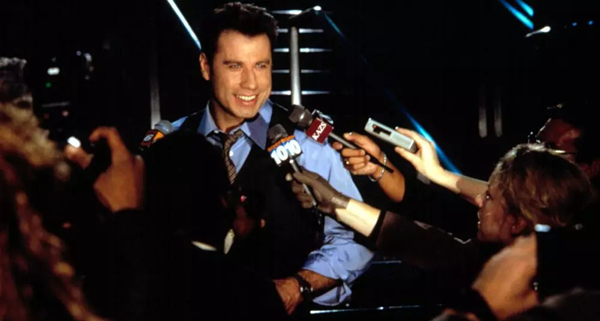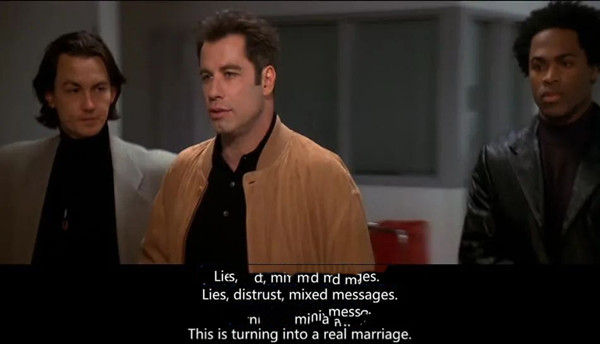“Face / off” enters time magazine’s top ten movies of the year

After its release in 1997, face / off won the box office champion of that month, with a total box office of US $112 million in North America and US $245 million in the world. It was selected as one of the “top ten films of the year” by time magazine of the United States.
One of the film’s two main characters is Nicholas Cage, who just won an Oscar for “Leaving Las Vegas”.
Another leading actor, John Travolta, also won the best actor Oscar nomination for his superb acting in “pump action”.

The famous scene of “Pulp Fiction” in vulgar novel
The actor, who was famous in the 1970s, went through the low ebb in the 1980s and was brilliant again in the 1990s. Face change has become a milestone in his acting career, winning him $15 million in Hollywood.

The movie tells the story of the FBI agent Sean after painstakingly catching the murderer Keith, in order to get the location of the gas bomb set by Keith in the city from his brother, he uses new technology to change his face with the comatose Keith.
As a result, as soon as Shawn incarnates into case and enters the prison, case wakes up from a coma, kills all the insiders of the incident, starts his life as agent Shawn, and realizes Shawn’s terrorist identity.

In order to regain his true identity, Sean and case launched a battle between good and evil. If there are too many plots, I won’t repeat them. Here are the highlights of the movie:
- The two men face each other, playing four roles
Both cage and Travolta play the roles of police and terrorists in the film. At the beginning, the two people who changed their faces were still a little strange. Then they got better and better. Sean sat with a group of gangsters and began to take medicine. He looked like a real terrorist. And case incarnated as “friend of justice”, relieved the bomb he had planted several days ago and became a city hero. The plot seems absurd and reasonable. During the duel, Sean called in his former Mafia friends, and case led a group of FBI special police. The final showdown is even more funny. Case’s girlfriend helps Sean block the robbery and dies, while Sean’s daughter shoots her father for case. Confrontation is the best form for the protagonists in Wu’s films to fight, and it is also the fuse for the outbreak of conflict. Cage and Travolta, a pair of Oscar class actors, are equally matched, and they have recreated the classic “double hero” routine.

The plot seems absurd and reasonable. During the duel, Sean called in his former Mafia friends, and case led a group of FBI special police. The final showdown is even more funny. Case’s girlfriend helps Sean block the robbery and dies, while Sean’s daughter shoots her father for case. Confrontation is the best form for the protagonists in Wu’s films to fight, and it is also the fuse for the outbreak of conflict. Cage and Travolta, a pair of Oscar class actors, are equally matched, and they have recreated the classic “double hero” routine.
Brother cage has a very melancholy face. It seems that many people owe him money, and they still owe it. Brother John has a happy face. It seems that he owes cage a lot of money.
- Classic reappearance: “endless bullets, endless pigeons”
American critics say the film:
“Beautiful slow motion continuous action, staccato editing and ingenious frame setting are action movies with a new depth of emotional and visual beauty, and a blend of highly violent style and personal plot.”
John Woo’s films have always been famous for their violence aesthetics. This time, he brought his “white dove Temple” style windbreaker, double guns, church, white dove, confrontational police and bandits, as well as the fierce and exciting gunfight to Hollywood. The whole action play is full of joy!
With strong sound effects and the classic “Wu Style” slow motion lens, the scene of a tree shaking car crashing into an airplane, a tit for tat speedboat crashing into a speedboat, and still not firing bullets, is grand and dazzling.
During the gunfight in the gangster’s nest, Adam’s headphones rang out the theme song “over the rainbow” of the wizard of Oz, which won the Oscar for best music. It was like a flowing stream, flowing silently through the crowd and soaking in the heart.

The muzzle of the gun whimpered to break the tranquility of the sands of sunshine, and then the sound continued. In the church, Jesus looked down at his people sympathetically, and the dove, a symbol of peace, ran in a panic. John Woo’s movies have always been a quack. He uses hot weapons instead of cold weapons to learn from Zhang Che. But whether they are good or bad, they always carry out their creed, as always.
- Good and evil change face but not heart
“Face changing” is not only well received by passers-by, but also in the eyes of professional film critics. The film connects the exaggeration of imagination with the complexity of reality, and adds philosophical significance. It raises a question: when the cognition of identity deviates or completely changes, how do you survive in a new identity? When they changed faces, they adapted to each other’s lives. Even at the earliest stage, they did better than the original hosts of the face. Sean made case’s wife and children feel love and respect for the first time. But Keith used his own unique way to light Sean’s wife’s heart as if he was dead, and make complaints about the daughter who had taken the wrong way back to the right track.

But even if case changed his face, he still couldn’t change his nature. After his brother’s death, he angered his subordinates and created the unexpected death of his boss. Sean keeps all the goodness, even in the face of his colleagues who are not sure of his true identity, he still shows the greatest kindness, never kills innocent people indiscriminately, and even gives his wife respect and care.
In the end, case taught Sean’s daughter to use a knife, but finally hurt herself. Keith’s wife, on the other hand, died trying to block a bullet for Sean. At the end of the film, John Woo uses the familiar happy ending to give the answer: if you take care of yourself, you will see the light.
In general, John Woo’s Hollywood masterpiece is a perfect example of transplanting his own Hong Kong Style action film style into Hollywood. It is chivalrous, hearty and romantic. With the exchange of good and evil, the penetration of right and evil, the audience’s psychology is stretched and pulled in the process of changing shape and position again and again, and the plot tension of the story is sublimated and strengthened. Both the familiar Wu style aesthetics of violence and the self-examination of self-restraint are very interesting and memorable, which can be called a classic.

